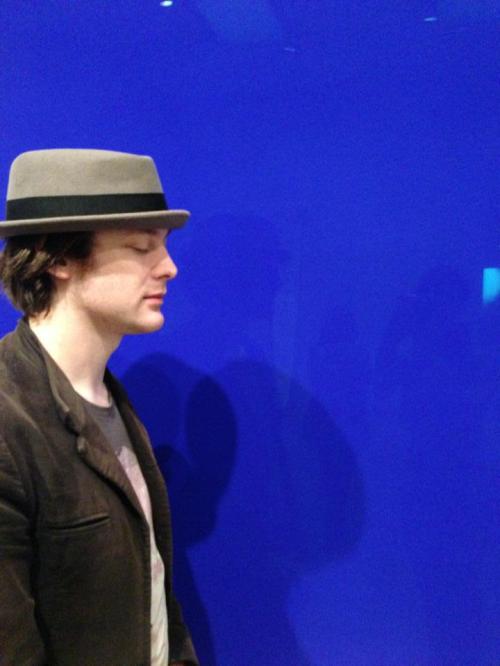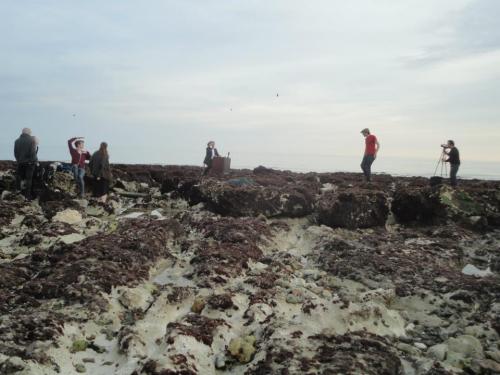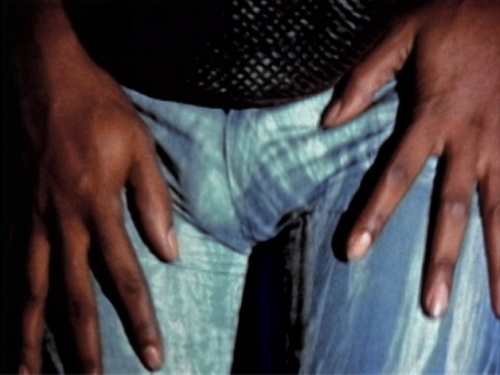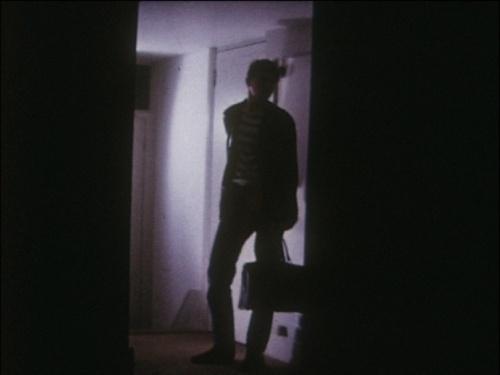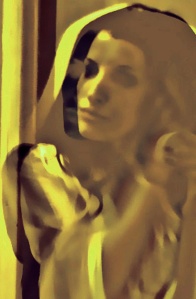Nick Hudson interviewed by Caroline Simpson
Nick Hudson is a singular talent. Based in Brighton, Hudson, a musician, has a prodigious output, having produced four albums (My Antique Son, 2010, Territories of Dissent, 2010, A Day without Comfort, 2012 and Letters to the Dead 2012) over the past three years, which not only does he write, perform, play most of the instruments – he also records and produces himself.
Praised by outsider luminaries such as David Tibet, Jeremy Reed and Julian Cope, Hudson’s music is spectral, creepy and menacing. Every song is a dark jewel, like ancient amber with an insect entombed inside. He is Pinky’s long lost brother; a wraith in Brighton’s labyrinthine back streets, whose stately and melancholy music is not only beautiful and strange, it is also disturbing, hinting at a world that is there, but is elusive – just out of reach.
Unrestrainedly and unabashedly ambitious, Hudson has now ventured into multimedia presentation having directed a film last summer to accompany, or augment, his latest recording Letters to the Dead.
As he sings on My Antique Son, “creeping, morbid, hopeful chant, And nervous, merry dance”.
Below is a conversation I had with Hudson, last autumn, in London.
When did you start making music?
I started playing violin at five, but never pursued it, because the teacher seemed like an alien, used to make us walk around the school with our violin on our shoulder. I then took up piano, essentially because of my Auntie Penny, who died in 1989, and was in a band called Room 101, who were at one point much loved by John Peel and Billy Bragg. She gave me a keyboard a few years before she died of cancer, and she gave me a keyboard and I started working stuff out on it, and my parents recognised that I had seemingly some affinity with it, so they bought me a piano and got me lessons.
I realised fairly quickly that I wouldn’t be concert pianist material – my sight-reading always suffered compared to my capacity to improvise. I think I was always inclined more towards a creative route than an interpretive one. Then I started playing guitar when I was ten, I’m totally self-taught. My technique’s not remarkable, it’s singular in that it’s me – replete with all the flaws that brings. And I got my first singing lesson when I was 23. I never really intended to sing.
I was living back at home where I started writing songs, saved up enough my money buy myself a laptop and a really crap mic. I downloaded some software. There was obviously some latent discharge waiting to happen ‘cause as soon as I had the capacity to record, I just went apeshit and started hemorrhaging songs. Then it was by default, “Ooh, I have to sing these, because there’s nobody else around – it’s Lincolnshire!”. I’m self-taught as a producer, and my ear for that and knowledge of the software is just through trial and error – plenty of the latter – but they’re starting to sound pretty decent I think.
And how did you get from Lincolnshire to Brighton?
I moved back after university, and it was something of an awful decision – I just think you get thrown into the same old behavioural archetypes that you had before you left. I became a teenager again, my dad became an oppressive monster again, which of course he isn’t, and I got generally very depressed and kinda decided that I could either stop there or write my way out of it.
How did that come about?
The writing gave me a lot more confidence and I’d also started corresponding with an author called Dennis Cooper.
I’ve never heard of him!
I know you haven’t!
Was that through the blog?
No, it was way before the blog. I emailed him personally. I’d just starting writing songs and I think it was reading his novels that gave me the confidence to write about the things I was addressing in my lyrics.
So this was about seven years ago?
And, the early lyrics were all quite stark, naked, confessional and, um, deeply unpleasant. (Laughter). I wrote to him, as a kind of nervous, delayed, adolescent. And he emailed me back. I sent him some music, and he replied saying, “Oh my god, this is really fucking beautiful, who are you? What’s your background?” And we became friends. This gave me a great deal of confidence to continue to write and explore these things in more detail and develop as a writer and an artist.
Prose and poetry were happening simultaneously with music anyway, and it was only when I was about 23 that I started twinning the writing and the music together. I think the confidence writing gave me, led me to looking to ways to move on from Lincolnshire. After this I ended up living in Crawley for a year or two.
Was this by yourself?
No, I was a lodger at some absolute nutjob’s terraced house.
How did you find that?
Family friend. And, y’know, we had fun. He was a challenging man in every sense, often in good ways, but … I wasn’t employed very much at the time so I was able to hone my craft, and write constantly. I mean, I think I did something like seven albums within three years or something stupid like that. And then minutes within arriving at Crawley, I got on the train to Brighton. I stepped off the train there and immediately thought, “Oh, I want to live here”. And within two years I was.
Apart from Dennis Cooper, what are your influences, music or otherwise?
They are as wide and varied as you would hope … Mmmm. I guess the real stayers, the enduring ones, are the absolute singular mavericks like Bjork … and Scott Walker, who I adore – every single stage of his career I adore, and a lot of the Eastern European contemporary classical composers like Penderecki and Gorecki and other names with the suffix “-esci”. His Symphony of Sorrowful Songs I listened to when I was 16 and it’s still one of the most strikingly beautiful things I’ve ever heard. Yeah, just something about the pace, orchestral texture and harmonic voicings really kicks my arse.
And although I don’t make dense modern classical music myself, it’s there, partly because of my training, partly because of my listening, there’s an influence, even if it’s understated. Who else? Lots of film-makers actually. People like David Lynch, Terrence
Malick and Tarkovsky, who most recently has been utterly caning me.
And writers?
Burroughs, predominantly.
Why?
I think … I regard him foremost as a social philosopher in some sense, and as part of a potent lineage with Crowley, Genesis P-Orridge, Coil, and quite aggressive countercultural stuff. And the cut-up work he did with Brion Gysin has been hugely influential on my approach to editing in whatever medium I’m working in. Extreme juxtapositions within one piece I guess.
Why do you like that?
I guess I’ve always responded to collage, intuitively or whatever. It’s exciting to me to have lots of data densely crammed into one little announcement or something. I don’t know. It works for me. And also, I guess like the modernists. They’re attempting to present an idea of consciousness with a greater accuracy than 19th-century novelistic fiction had ever done, and I find that really compelling. And also, Burroughs’ life is fascinating too. He’s kind of everything that society currently detests and deplores – he was a wife-murdering, misogynistic junkie. So, y’know …
What’s not to love?
Exactly, role models.
So you were in Brighton, you’d made lots of material.
Yep, too much some might say.
And you started to release these?
I always used to record as I’d write and I still do to a degree. It’s a slower process now as I’m better at recording, so it takes longer. The early stuff was very lo-fi and quickly produced. I’d barely edit. I was pretty much haemorrhaging songs as I’ve said. I’d always write and record pretty quickly. I did a seven-album cycle called The Phoenix Diaries which was me trying to write my way out of behavioural idiosyncracies that I found objectionable in myself … slightly fucked-up sexual stuff and …
Can you possibly elaborate?
You want me to elaborate? My mum might read this! Without labouring it, because it’s by no means an abuse tale on the level of intensity often reported, and rightly so – but there were incidents. Every adolescence is thorny, of course, and there were small, violent components to my forming. Little episodes with an older kid in my village. He was a speed freak. It’s all in the lyrics. And that kind of confused my approach to enjoying a healthy sexual dynamic for a while. That’s what most of the early cycle is – me trying to write my way out of that malingering bollocks. And then I started sending The Phoenix Diaries to various people.
Like who?
Franko B, Dennis Cooper, Alex Rose (he blogs with Dennis) who is an amazing artist based in Ireland. He is pretty reclusive. He has been a very fervent supporter of my early work who gave me a load of confidence, and opportunities. He is a really lovely human being. As I went on, I’ve just always entered into correspondence with people whose art I like, insofar as I can obtain their contact details, haha!
Go on?
Meredith Monk, briefly, which was lovely – when I got an email from her saying kind things about my music, I was kind of bowled over, y’know? And, Jeremy Reed and David Tibet, who wrote the foreword for My Antique Son – a record of mine that came out two years ago. Also, some photographers – Anthony Goicolea – he’s a Cuban-American photographer, his stuff’s really wonderful. His early stuff seemed to resonate with my early stuff – certain images he would use would appear in other forms in my own lyrics.
What’s Hexenverfolgung (this is a musical project of Nick’s)?
It’s German for witch persecution.
And who’s Kiddiepunk?
He’s Michael Salerno, a really good friend and another early supporter of my work who lives in Paris. I played at his wedding in Italy last year – a really amazing week. He started a label which started out as a cottage industry zine. Then he started a label and put out The Elegy, which was a fairly wintry folk record that I made about five years ago.
For ToD, I got loads of orchestral players in to help me out, and I was still recording on a shitty SM58, standard dynamic microphone, usually for live work, but it’s all I could afford. I was recording acoustic instruments on that and through trial and error mixing them so they might sound ok and not lose all of the breadth of texture that string and wind instruments have – that was a challenge.
We self-released that, and that’s the first time we rented St Mary’s Church in Brighton – this huge, cavernous church with mind-blowing acoustics – a three-second sustain. We performed the entire record in sequence with a ten-piece chamber orchestra. All through rehearsals, I was recovering from swine flu so I had a five-note range and was really cautious of infecting all of these wind musicians. But it went away just in time for the performance, and it went really well. Julian Cope reviewed the record – a profane and brash and crazy and lovely review.
And then My Antique Son happened. I got given a really brilliant microphone by a friend – a Neumann u89 – a £2,000 condenser mic, so a significant step-up from the SM58, which enabled me to everything with way more clarity, and to record sound sources that emit a lower signal. It’s really good for recording voices with. I went kind of nuts on My Antique Son. There’re loads of layered choral parts. I recorded throat singing and the organ and in the church, there are loads of doom metal influences on this one. It’s really progressive and psychedelic with a huge narrative. There’s a track – Hierocles – dedicated to Jeremy Reed on there, based on his book, Boy Caesar.
And that’s the first one where I’d say the production is something I’m pleased with. It took a good two years to make. It’s intensely sculpted, and feels more like theatre I would say. It traces a lineage of my own connecting between what I call my pantheon of gnostic saints – from Heliogabalus, via William Blake, Aleister Crowley, Johnn Balance of Coil, Rimbaud and so on …
After My Antique Son, which was a really collaborative record without about 15 people on it, I wanted to hole up and make something entirely solo. A Day Without Comfort still sounds like a band record in places, even if it is only me. It’s way more intimate and personal than My Antique Son. The coalition, of course, has kicked my writing into more political realms – it’s quite a ranty, sore, acrimonious record. It also addresses certain episodes in the life story of a really dear friend, called John Bacchus. He has a really fascinating life story, and so the lyrics are his life so far condensed into a single day. It’s a more ballad-infused affair.
This brings us to Letters To The Dead. What were you trying to achieve with it?
I guess I tend to be quite reactionary. Every record seems to rebel against the processes, motives and shape of the previous one. I’d made this solo record, A Day Without Comfort, that set out to be very pop, insofar as I can conceivably go towards pop, which I’ve discovered is not very far. In its production style, I was consciously aping Stephen Street’s work with The Smiths, and also certain Martin Hannett qualities – so an eighties agit-pop record essentially. Letters To The Dead is utterly different. I was bored of compression and waveforms that look like a brick.
I knew I was going to make a record with very little compression. I’ve used lots of programming, and synths, post-production in the past. With the new one I wanted to record with very little post-production and use mainly acoustic instruments – that became the sonic blueprint. I also wanted to make a straight-up narrative record. The narrative was written way before I actually began conceiving of it as a record. It’s an opera of sorts. Although that term intimidates me somewhat, so it’s essentially a narrative record. I wrote the narrative, then started writing the lyrics which would convey the narrative, without being flatly expository, and then I started composing around them.
By this point I’d developed friendships with various members of really brilliant modern-compositional cult bands from NYC and Seattle, who’d all come from either the John Zorn milieu or from a Sunn O)))/Earth doom-y background. I developed a friendship with Stuart Dahlquist who operates a band called Asva. Stuart was the original bassist in Sunn O))) and was in Burning Witch. And his band Asva are incredible. And every album they make, the further away from traditional doom they get.
The new one has shades of Arvo Part, and features Toby Driver from Kayo Dot on vocals. I’d just gotten into Kayo Dot, and it was a total headfuck epiphany of a band to discover – totally kicked my arse when I heard them – it’s through-composed, but uses – especially in the early stuff, it’s gone even farther out now – rock instrumentation.
And we put them on in Brighton when they played their last UK tour, and hung out, and stayed in touch and developed a lovely online friendship, and now many of them appear on Letters. Toby, and various members of Kayo Dot, and satellite bands all contribute amazing parts. It has led to the record taking ages to make. Obviously if you’re collaborating with loads of people you have to wait for their schedules to allow for them to develop their contributions. I also recorded a ten-piece choir of amazing Brighton singers in St Mary’s Church where we premiered the show.
The record’s now done. It’s being released on Antithetic Records which is run by just one guy, called Shawn. It’s an amazing DIY label, limited edition, in beautiful sleeves. Shawn really liked My Antique Son and we discussed doing something together. That turned out to be Letters To The Dead. But also, I never conceived of it as just a record – it’s a performance as well, a film and a libretto booklet. It was more a case of isolating a narrative, refracting it through various media and seeing how they interact in the public forum. The libretto booklet will feature all of the lyrics, scanned working notes, visual art, etc.
So all the instruments.
Yeah, I used some really beautiful pianos on Letters … for the lingering sonorities that my stage piano unfortunately can’t simulate. And Letters … is quite a sparse album so to have those hanging, sustained tones was important. I had to blag my way into studios for free, or save up and rent rooms with pianos and good mics. Tim Byrnes is an amazing trumpet/flugel-horn player from New York who plays with Kayo Dot and his own outfit Hazel-Rah – provided a five-part brass arrangement of the opening track Bad Atoms – his contribution made for a really striking overture.
There’s a séance sequence in the narrative, and for that I wanted to exploit the human voice in unusual ways. I explained to the choir that I wanted them to respond to the vertical axis of my hands. When I’d raise my hand, they’d raise the pitch. They were doing long sustained notes and I was conducting them a bit like a theremin.
Can you tell us about the narrative?
It started pretty free-associative. Then I stripped it down into a more straightforward narrative. Basically, it tells the story of a woman who in the prologue abandons her child through bearing a complete lack of maternal compassion for it. Then it cuts to news footage of this being reported, and of the mother disappearing after the abandonment, and how the child hasn’t been found and how only the father remains. The father’s long-estranged from the family – barely even met the child. Then it relates to a tale from the 1970s – a cult of fathers who were obsessed with battling over-population and would ritualistically abandon their first-borns into the ocean.
Is this true?
No. Haha. And then in the background you can see footage of three fathers abandoning three children into the ocean, and they sail off. And then the piece really opens – the estranged father is a writer, he has his writing desk moored on the rockpools right at the fringe of the ocean. And he’s witnessed writing three open letters to his estranged child – each letter is a song. Every time he finishes writing a letter, he folds it into an origami sampan and sails it off into the ocean, like a message in a bottle.
Then we wind back about a hundred years – there’s a Victorian spirit medium called Leonora Piper, who was “tried” by William James – Henry James’ younger brother, and a psychologist – and him being a man of reason and empiricism. He was obviously sceptical, and yet he deemed this particular spirit medium’s psychical capacities so convincing that he became besotted with her. There’s a quote from him – “in order to disprove notion that all crows are black, you must but produce one white crow” – which I thought was pretty poetic. That’s why there are white crows dotted about the scenography and the film that’s attached to this project too.
Then we cut to a séance, and the mother from the prologue, is played by the same person who plays Leonora Piper, to imply a connection in the sense that they’re outlaws from what society would rather they be, so a séance happens, and she invokes three sprites from the ocean – undead, ocean-dwelling, half-naked, seaweed-draped sprites – and these are the kids that we saw being abandoned in the newsreel footage, and so there’s obviously some abandonment issues.
We then cut back to present day and the séance turns into a trial – as I figure they’re structurally quite similar – someone’s being tested, generally by sceptics. The mother is then put on trial by the trio of undead, ocean-dwelling sprites, and is banished into the ocean. At which point, the child from the prologue sings a reprise of the overture addressed to his mother.
What do you hope to do with it?
We premiered it on November 5 at St Mary’s Church in Brighton – with giant origami sampans (boats) constructed from the letters, strobes, televisions emitting static, crows dotted about the space, and a causeway of candlelight. We’ve also made a film to compliment it – kind of a cinematic album – a short feature – we had this screened at the Duke of York’s in Brighton in October. A lot of the performers who appear on the record also appear in the film. The album’s coming out on vinyl, CD and DVD and as a libretto booklet. We screened the film as we performed it too. I made the film with my collaborator Chris Purdie, who’s a really brilliant director who’s done stuff for Asva. We had a big shoot in Brighton which involved me taking the desk from my room about two miles up the road to the rock pools beyond Brighton Marina. My friend Gary Goodman, a poet, played the father. I sat him at the desk, writing the letters, gazing wistfully out to see and folding them into the sampans. I felt a bit like a poor man’s Herzog carting the desk up there.
And we got some really beautiful shots – timed it so we’d have peak low tide and sunset. It was about the first good weather we had all year. I got footage of the sprites coming out of the ocean. The cast are all really good friends and did an amazing job – covered in slimy kelp and writhing about in the sea.
So just a general question – what drives you creatively?
Erm. I’m probably quite naturally quite depressive and so in order to stave off the black dog, I keep myself really busy. Obviously I get huge intellectual and emotional satisfaction from working on it, and of course, it derives from some emotional core that it’s a little bit skewed in me. I think most writers maybe do it because they have an inability to express stuff in a more direct way. I’ve always liked telling stories –manipulating words, sentences and music.
Let’s not forget it’s fun. The fact that I can do most of it from home is enormously liberating, as much as the democratisation of music that home recording allows – that can also produce a lot of shit. I think on the whole it’s an excellent thing. It’s occurring in most cases despite the industry.
And we’re essentially totally independent. There’s no big labels courting or moulding us. All the labels that we work with are often one person in the room who has an equally zealous thirst to do this kind of stuff. Not that I would mind of course if some demented Russian oligarch decided to bequeath four billion pounds upon our creative acts, but in the meantime I’m happy to pursue bigger and more ambitious projects on whatever terms we can summon.
One last thing. What’s the best thing that’s happened to you creatively?
I’m going to have to think carefully about this. Ok. It’s all pretty exciting. It’s all challenging. But, hmmm. I’ll list a few highlights. One of them – playing in the cellar of a medieval castle in Italy last year – that was incredible. And the acoustic – I don’t really like PA systems – I prefer naturally amplified sound, so that was an incredible setting and a beautiful circumstance in which to perform.
Putting on Kayo Dot was pretty brilliant, and then developing friendships with them, and that leading to New York connections and the sense of this international community of mutually supportive artists coming together. And the first ever concert we did in St Mary’s Church three years ago, where we did a unamplified, candlelit performance with a ten-piece chamber orchestra. That was pretty special. This gave me more confidence to think – “ok, I can push this – we can be ambitious”. And, I’m really proud of My Antique Son, I think it’s a really strange record that can proudly sit in the corner doing what it does. And, it IS really odd.
And low points?
Usually the low point in the making of a record is when the hard-drive crashes and I lose half the album. It’s not happened so much of late because I’ve become a raving paranoiac about backing up, but there’s a whole other version of My Antique Son somewhere out there in the infinite multiverse that’s completely different to the one that got released. Otherwise, I don’t really dwell. I try and keep myself busy. It’s very easy to get swallowed up into some kind of hole.

